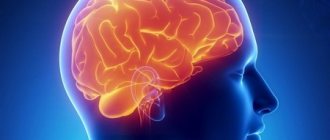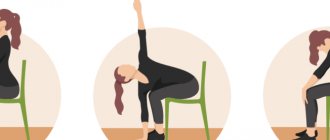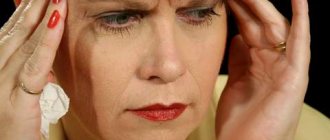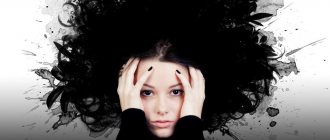Main signs of panic disorder
- Repeated attacks of panic attacks
are
sudden episodes of severe anxiety, episodes of inexplicable intense fear
(for example,
fear of death, fear of going crazy, fear of losing control of oneself,
and others).
Panic attacks
typically have
an unexpected onset
- without warning signs or apparent cause.
Specific fears
(
heart attack, stroke, fainting,
etc.), they force the patient to constantly measure his pulse, blood pressure, and do repeated electrocardiograms.
Panic attacks do not pose a threat to human life or health
, but they are a frightening condition in which
a person cannot control his feelings and emotions
and becomes completely defenseless. - Autonomic symptoms
developing suddenly and reaching their peak within the first 10 minutes: pulsations, palpitations, rapid pulse; - sweating;
- chills, tremors;
- feeling of lack of air, shortness of breath;
- difficulty breathing, suffocation;
- pain or discomfort in the left side of the chest;
- nausea or abdominal discomfort;
- dizziness, unsteadiness;
- weakness, lightheadedness, faintness;
- numbness or tingling sensation (paresthesia);
- waves of heat and cold;
- insomnia;
- feeling of derealization, depersonalization.
(in 60-80% of patients with panic attacks), which are caused by
pathological anxiety
.
There is also a clear relationship between the severity of the disease and concomitant sleep disorders. Patients with panic disorder complain of difficulty falling asleep
,
unrestoring sleep
, and characteristic
nocturnal panic attacks
.
In only 25% of patients, panic attacks occur exclusively while awake. Most patients experience an attack at some time during nighttime sleep, and 30-45% of them experience repeated episodes. 21% of patients experience sleep panic attacks, and in 54% panic attacks occur both during wakefulness and sleep. Nocturnal panic attacks
are manifested
by sudden awakening
(waking up from the feeling of being unable to inhale or exhale, forcing the patient to jump out of bed, open the window, lean his hands on the windowsill to use the accessory respiratory muscles; often experiencing dizziness and cramping of the fingers), all the symptoms characteristic of panic attacks .
There is a delay in bedtime, frequent awakenings, and a reduction in total sleep duration. Patients, fearing a recurrence of night panics, deliberately deprive themselves of sleep
, exacerbating the already pronounced insomnia symptoms, which leads to more serious disorders and generally
reduces the quality of life
of these patients.
How to detect a heart attack
Causes
Chest pain does not always indicate the development of a heart attack; it often occurs with arrhythmia, a sharp increase in blood pressure, and in patients with coronary artery disease. The cause of the attack is associated with insufficient oxygen supply, decreased blood supply to the myocardium, or thrombosis of a large vessel. Atherosclerosis is often a predisposing factor to its development. In older people, cardiac dysfunction is associated with age-related dysfunction of the cardiovascular system.
Provoke the development of an attack:
- diabetes;
- taking non-steroidal drugs for a long time;
- increased body weight and metabolic disorders;
- smoking, alcohol abuse.
Each condition is characterized by its own symptoms and manifestations.
How does a heart attack manifest?
A myocardial attack occurs suddenly or develops gradually. It is characterized by symptoms:
- pain in the heart area, in the center of the chest or in the left half. The pain has varying degrees of severity, can increase in intensity, and last more than 10-20 minutes. Feels like a feeling of fullness, burning, compression;
- feeling of discomfort in the jaw, face, neck, shoulder on the left;
- shortness of breath, difficulty breathing, inability to take a deep breath.
In addition to the characteristic signs, symptoms such as headache, dizziness, chills, sweating on the face, nausea or vomiting are also observed.
Symptoms have some differences by gender and sometimes take atypical forms. In men, a few hours before the development of the pathological condition, heartburn, belching, and nausea may appear. With such symptoms, cardiac dysfunction is often regarded as food poisoning or an exacerbation of gastrointestinal diseases. An attack can also manifest itself as wheezing, coughing, or increasing respiratory failure.
In women, neurological symptoms are more common. Coronary syndrome is masked by constant fatigue, increasing weakness, and sleep disturbances. Blurred vision, unsteadiness when walking, tingling in the arms and legs appear.
In some cases, patients do not notice a deterioration in their health and they have no symptoms of an approaching dangerous condition. The absence of any signs indicates the development of an atypical painless form. In this case, you should be alert to unmotivated weakness and causeless fatigue that appear after physical or emotional stress.
Often cardiac disorders are accompanied by panic attacks. And in these cases, it is extremely important to be able to distinguish a panic attack as a symptom of an attack from a condition caused by stress, VSD or mental disorders.
What is a panic attack and its main symptoms
Panic attack is a neurotic disorder characterized by the appearance of sudden anxiety and fear in combination with somatic symptoms. The unpleasant state lasts from several minutes to several hours, but on average – up to half an hour. It is more often observed in young women under 30 years of age. Its symptoms are similar to those of a heart attack.
A panic attack causes:
- chest pain;
- difficulty breathing;
- dizziness;
- severe weakness;
- nausea and/or vomiting.
How to distinguish a panic attack from a heart attack with the same symptoms? It is recommended to take into account the circumstances under which the unpleasant sensations appeared. If against the background of stress, most likely it is a panic attack; after physical exertion, it is a dysfunction of the cardiovascular system. There are some differences in the nature of pain. During a panic attack, the pain in the chest is sharp and “prickly”, localized in the center.
Breathing exercises help to cope with this condition. But, if there is no improvement within a few minutes, in order not to miss a heart attack, you need to call an ambulance.
Chest pain does not always indicate a heart attack. Unpleasant sensations are caused by a variety of diseases, including those that are not life-threatening. But if characteristic symptoms occur, you should immediately seek help to minimize the risk of cardiac complications, and often save lives.
Sources
“Heart Attack Symptoms, Risk, and Recovery,” US Centers for Disease Control and Prevention https://www.cdc.gov/heartdisease/heart_attack.htm
"Heart Attack", UK National Health Service https://www.nhs.uk/conditions/heart-attack/
"Warning Signs of a Heart Attack". American Heart Association https://www.heart.org/en/health-topics/heart-attack/warning-signs-of-a-heart-attack
Approaches to the treatment of panic disorder
The most effective is the combined treatment of panic disorder - a combination of drug treatment with psychotherapy
.
Selection of an individual treatment regimen
is possible only after a thorough examination and is carried out taking into account all
the characteristics of the disease
.
When determining therapeutic tactics
the following factors are taken into account: duration of the disease, the patient’s attitude to pharmacotherapy, previous treatment experience, the nature and severity of emotional disorders, the nature of the psychogenic situation, the degree of social maladaptation, the presence of concomitant somatic disease.
Benzodiazepine tranquilizers are most effective for relieving PA.
.
Antidepressants are also effective in treating panic disorder
. It is recommended to use SSRIs (selective serotonin reuptake inhibitors) or SNRIs (selective serotonin and norepinephrine reuptake inhibitors).
An integral component of the treatment of panic disorder is psychotherapy, which is used both independently and in combination with pharmacotherapy. It is known that in a high percentage of cases the effect can be achieved only with the help of psychotherapy. The most important goal of psychotherapy is to gradually bring patients to an awareness of the essence of their psychological conflict and then to a gradual modification of previous inadequate schemes and attitudes and, ultimately, the development of a new, more harmonious and flexible system of views and relationships, more mature adaptation mechanisms, restoration of self-control and adequate response.
Non-medicinal products are also used
(physiogenic, psychotherapeutic)
methods for relieving
panic attacks:
- regulation of breathing (breathing into folded palms, breathing with the stomach - exhale longer, slower than inhale)
- distraction (concentrating attention on surrounding objects and events; physical activity; singing; walking; counting; auto-training)
- massage (shoulders, neck, little fingers, base of thumbs).
Symptoms of panic attacks:
- I wake up at night with a terrible heartbeat, gasping for breath, with a feeling of an imminent catastrophe, a disaster that threatens my health and safety.
- My home is no longer my castle, and I want to run out of it in a panic.
- Part of me knows that nothing has changed, that I will live and what is happening to me is not the end, but that doesn’t make it any easier.
- This can happen to me during the day, for no apparent reason, when everything goes on as usual - suddenly breathing becomes incomplete, it seems that no matter how much you inhale there is not enough air, the heart is pounding, a feeling of unreality appears, or the fear of dying becomes unbearably clear.
- When this happens for the first time, it is extremely frightening.
Then - either immediately, or through a series of requests in this state for help from doctors - an understanding of one’s condition, whose name is a panic attack, comes.
During a panic attack, adrenaline is released into the blood - and this is more than normal, because a panic attack is a set of physiological reactions to a sudden danger, a threat, but in its absence. Our body does everything to save itself:
- blood is redistributed to the muscles and heart, “flowing away” from the surface of the skin - so it cools and sweat appears from the internal organs;
- the muscles tense, ready to run away or defend, and this tension manifests itself as trembling in the hands and body;
- the heart accelerates and intensifies its work, pumping blood into the muscles and therefore the pressure increases and the heartbeat increases;
- growing anxiety, the desire to leave the “dangerous” place is manifested by rushing and agitation, which supports the pathological process.
What should be done to stop or at least muffle a panic attack if it happened now, and a doctor and psychologist are still far away?
- Distract your attention, switch it from your bodily experiences and intense fear to the outside world - count the floorboards on the floor, multiply in your mind, rank objects, read poems.
- Talk to other people - loved ones, random passers-by. This gives a feeling of security and distracts from panic.
- If there is an opportunity and need, scream into the pillow with all your heart, this makes it possible to relieve internal tension.
Breathing is the first mistake: when you panic, try to breathe intensely. Excessive blood oxygenation and blood depletion of carbon dioxide confuse the respiratory center and it does not send the command to inhale. There is a need to control our breathing, the fear of suffocation intensifies, we breathe more often - and dizziness, pain, tingling in the chest occur, and there may be cramps in the calf muscles. All these manifestations increase anxiety, as if they “confirm” the seriousness and danger of the growing symptoms.
Treatment of sleep disorders in panic disorder
The use of hypnotics (drugs with a hypnotic effect) in a short course may be promising if sleep disorders predominate in the clinical picture in order to prevent the severity and chronicity of the disease.
Antidepressants are recommended for long-term use as sleeping pills without the risk of developing addiction and dependence.
with sedative effect and melatonergic drugs. In case of chronic insomnia, priority goes to non-drug treatment methods, among which the leading one is psychotherapy.
What can you do if you have a panic attack?
Breathe into a paper bag, plastic glass. Do not use plastic bags under any circumstances, as they may block your airways. It is important to exhale into the bag and inhale air saturated with carbon dioxide from it. There is no need to force your breathing or speed it up.
Coping with a panic attack is a big deal, but it is not the solution to the problem as a whole. In order to get a long-term result, it is worth resorting to structured help - psychological counseling, psychotherapy, drug treatment combined with psychotherapy. Mastering the skills of recognizing bodily sensations during a panic attack, interpreting these sensations as not threatening life and health, and influencing the core of anxiety with medications helps get rid of this illness and achieve a satisfying quality of life.
How to treat panic attacks?
Two groups of drugs are tranquilizers and antidepressants.
- Tranquilizers - yes, addiction to this group of drugs can form if taken incorrectly: for a long time, without indications. The period for which the psychiatrist prescribes, the daily dose of the drug, and its timely withdrawal prevent the development of addiction. The tranquilizer quickly, in a few minutes, relieves anxiety, relaxes muscles, and normalizes blood pressure. This is similar to the effect of antipyretic drugs for sore throat.
- Antidepressants treat anxiety disorder and panic disorder. But this group of drugs begins to develop its effect in the second week of use, and completely - in the fourth to sixth week of use. Then a therapeutic stage for 2–6 months, then a supportive, anti-relapse stage. And freedom from pathological anxiety.
Contact us, we will help you!










